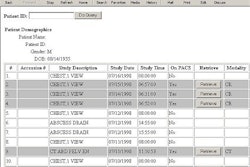By Dr. Phillip Berman
Mammography screening in the U.S. has been on the defensive for the past several years. A small but vocal group of researchers has questioned its intrinsic value in preventing deaths from breast cancer, while newspaper headlines have emphasized mistakes made by screening providers.
Some providers take the position that, with reimbursement low and malpractice exposure high, the service simply isn’t worth the hassle. And the U.S. government is watching over all of it, prepared to step in with increased regulation if needed.
In the following editorial, AuntMinnie founder and practicing radiologist Dr. Phillip Berman offers some facts and opinions on addressing the mammography crisis.
Here are some generally true and, I think, barely arguable statements about mammography in the U.S., which for the sake of this argument should be taken as facts:
- Mammography screening saves lives and improves outcomes in breast cancer. It should therefore be regarded as a public service.
- In the best hands, the average detection rate of cancer in a screening setting is about 90%-93%. In the community, we all know it is substantially lower than that.
- Mammographic error is the cause of the greatest amount of litigation against radiology. And the litigation is generally successful, with the average settlement exceeding $200,000 per successfully litigated incident.
- Insurance companies pay very poorly for mammography, particularly considering the stress, risk, and high public value it involves. The average reimbursement does not fairly reflect the public health value or the risks of litigation entailed in providing screening services, nor does it permit a reasonable or equitable amount of compensation when compared with other professional opportunities for the radiology workforce (which is already in short supply).
- Residents don’t want to pursue mammography in a fellowship or as a subspecialty for a variety of reasons, including poor pay, stress, and litigation.
- Over the past decade, image quality has improved substantially as a result of voluntary certification from the American College of Radiology, and subsequently intrusion by U.S. and state governments. Many facilities have closed and mammography services have generally been concentrated into more capable hands and in better facilities.
- Through our professional efforts and the efforts of our societies and scientific colleagues, mammography screening has become pervasive over the past two decades in the U.S.
Now, here are some opinions that I think most of us would agree with. The population of screened women, the social fabric, and the radiology community as a whole would be better served if:
- Fair or even good compensation for mammography screening services were provided by payors.
- A less stressful, disruptive, and personal mechanism of adjudicating injury from interpreter error existed.
- The best mammographers -- that is, the people who have a gift for detecting cancer from a stack of screening films -- performed mammography and those of us who are less gifted did not.
Before I propose how I think all of this could be accomplished, we have to collectively face some less-than-happy facts. We all have been trained in and live with the concept of an "imaging chain" -- we all know that the weakest link defines the strength of the overall imaging chain.
In mammography, we, the mammographers, are the last link in that chain. And right now, we are probably the weakest link in that chain. I say probably because very few (perhaps none) of us really know how sensitive or good we are at reading mammograms.
Over the past 20 years we have dutifully improved every link in the imaging chain through voluntary action and even government regulation and inspection. At the same time, we have successfully persuaded the general public to participate in mammography screening.
But the only improvement in the "radiologist" link of the chain has been to require us to perform 480 interpretations per year and 15 CME units every three years. No testing of radiologist sensitivity or competency is required, and there is no organized oversight of screening providers to assure the screened public of any uniformity or reasonable examination sensitivity in detecting cancer. As a result, we are failing to measure the strength of the single most important link in the mammography imaging chain.
We would all like to believe that being certified, reading an adequate number of studies, and taking an adequate number of CME credits automatically makes us competent providers. Yet we all know that none of these activities defines the better screeners from those who are marginal and those who should not be screening; nor do these activities necessarily make one a better screener.
Somehow we expect bad screeners to figure out that they are bad screeners, or expect groups to identify those who are bad and then voluntarily remove them from duty. Even if such a voluntary system were to occasionally "retire" a suboptimal screening mammographer, which when it does is certainly no more than an occasional outlier event, is this any way to run a public screening program? No. And we all know it.
If every one of us knew what our screening sensitivity was as individual performers, we could potentially retire from mammography service those who shouldn’t be providing it and who aren’t offering the full value of the test to the public. We could regulate ourselves and we would have the data to do so.
The public value of mammography as a screening test would certainly increase if interpretation were concentrated in only the most capable hands. And imagine if the public knew our individual sensitivities -- it would demand the retirement of those at the bottom of the scale, but it would also have to come to grips with worsening scarcity of providers, inadequate compensation for the best mammographers, and the understanding that 90% accuracy means 90%, it doesn’t mean 100%.
Rating mammography providers is not likely to be popular in the radiology community, but this is the public’s health we are dealing with here. Remember, we are screening for cancer -- deadly stuff. If someone is reading at 80% sensitivity, do you want your mammograms or your wife’s mammograms read by that person? I don’t.
If you read at 80% sensitivity and knew it for a fact, would you read a stack of screening mammograms tomorrow morning? And if you answered yes, setting aside the money, wouldn’t you appreciate someone prohibiting you from doing it? Wouldn’t it be a relief?
This course of action, if taken, will undoubtedly create dislocations among providers and may even affect access to screening over the short term. But we know it’s the right thing to do. None of us want to admit we're not great at something. None of us want to stop doing something that makes the cash flow, and in which we have invested capital and time.
But the government pays farmers not to farm; it could pay those of us who do mammography and shouldn’t for some period of time, so that those of us who need to get out of a business for the public good can do so without financial penalty.
The government should also, as a matter of rectifying our presently ineffectual system of public health screening, build a no-fault environment for errors. If it did, the system would be fixed. Incentives would be increased for those who have the gift; the exit would be greased for those who don’t. The stresses of errors would be mitigated and some incentive would exist for young people to train and enter the system, which truly serves a public good.
We all want to be paid at a rate that reflects the intrinsic value of this exam, so we must find a way to uniformly perform at a level that reflects the intrinsic value of the exam. To do this we need to be tested and scored, retired and promoted.
This is cancer. This is public health. It is important for us as a community and for the community we serve to do the right thing. The current system compensates us poorly, and provides a suboptimal health service to the public. It’s time to fix it and the most important piece of the puzzle. The last link in the imaging chain needs strengthening.
By Dr. Phillip BermanAuntMinnie.com contributing writer
August 29, 2003
The opinions expressed in guest editorials are those of the author, and do not necessarily reflect the views of AuntMinnie.com.
To read responses to this editorial, click here.
Related Reading
Radiology residents not interested in reading mammograms, June 9, 2003
Driving improvement without driving the docs away: rethinking the MQSA, May 27, 2003
Radiologists say training, not tests, will hone mammography skills, April 10, 2003
Lawmakers mull mandatory testing of radiologists' skills in reading mammograms, April 8, 2003
Recently trained radiologists may interpret mammograms more accurately, February 27, 2003
Copyright © 2003 AuntMinnie.com


















